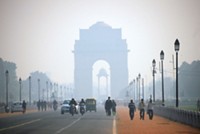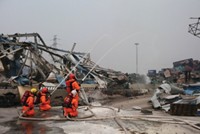Advertisement
Grab your lab coat. Let's get started
Welcome!
Welcome!
Create an account below to get 6 C&EN articles per month, receive newsletters and more - all free.
It seems this is your first time logging in online. Please enter the following information to continue.
As an ACS member you automatically get access to this site. All we need is few more details to create your reading experience.
Not you? Sign in with a different account.
Not you? Sign in with a different account.
ERROR 1
ERROR 1
ERROR 2
ERROR 2
ERROR 2
ERROR 2
ERROR 2
Password and Confirm password must match.
If you have an ACS member number, please enter it here so we can link this account to your membership. (optional)
ERROR 2
ACS values your privacy. By submitting your information, you are gaining access to C&EN and subscribing to our weekly newsletter. We use the information you provide to make your reading experience better, and we will never sell your data to third party members.
Pollution
Indian researchers develop ‘green’ fireworks that are less polluting
With smog blanketing Delhi, air quality concerns rise
by K. V. Venkatasubramanian
November 7, 2018

During Diwali, the Hindu festival of lights observed this week, celebrants illuminate their homes, pray, feast, and set fireworks ablaze. But those fireworks come at the cost of worsening India’s poor air quality. Just two days ahead of Diwali this year, a thick blanket of smog enveloped Delhi with pollution levels 20 times the safe limit. Smog kills more than one million people in India annually.
Leading up to the festival, India’s Supreme Court ordered on Oct. 23 that manufacturing and sales of fireworks—locally called firecrackers—be limited to those with lower emissions. The court also restricted fireworks hours to 8 PM to 10 PM for Diwali and 11:55 PM to 12:30 AM for Christmas and New Year’s Eve. Initial news reports from celebrations in southern India on Nov. 6 suggest that violations of the order were widespread.
Although they weren’t ready for mass manufacturing this year, researchers at India’s government laboratories have been working to reformulate fireworks known as flower pots and atom bombs to reduce air pollution and noise. Such fireworks have typically contained alkali nitrates, aluminium powder, and in some cases a binder to enhance luminescence. The aluminium powder is the primary heat source and produces the flash.
In the eco-friendly formulations, magnesium and magnesium compounds replace aluminium. The substitution reduces fireworks’ ignition temperature, which leads to a 25% decrease in emissions of particulate matter and reduces toxic gases and smoke. The new formulations also reduce or eliminate other chemicals such as potassium nitrate, sulphur compounds, and barium that affect air quality or affect health in other ways.
The formulations were developed at India’s Central Electrochemical Research Institute and National Environmental Engineering Research Institute (NEERI). “An emission testing facility has been established at NEERI and extensive testing is in progress for conventional and green crackers for monitoring the emissions and sound,” environment minister Harsh Vardhan said at an Oct. 29 press conference. The fireworks have been named the safe water releaser, safe thermite cracker, and safe minimal aluminium.
The formulations are also undergoing analysis and testing by India’s Petroleum & Explosives Safety Organisation, the government agency that sets safety requirements for manufacture, storage, transport and use of all types of explosive and petroleum products. If all goes well, perhaps the fireworks will be available to light up for Diwali next year.





Join the conversation
Contact the reporter
Submit a Letter to the Editor for publication
Engage with us on Twitter